Princetonians in Africa
Beginning in 1822, agents of the American Colonization Society established a small settlement at Cape Mesurado, a former slave-trading base on the Windward Coast of Africa. The colony served as a refuge for emancipated slaves and their descendants, thousands of whom emigrated from the United States. It also served as a landing point for African captives rescued from the transatlantic slave trade. Princeton affiliates were conspicuous in the foundation of the colony. Robert F. Stockton (class of 1813, non-graduate), a naval lieutenant, played a controversial role in securing the contract for land at Cape Mesurado. Stockton Creek, which became home to the African captives freed from the slave ship Antelope, was named in his honor. Robert G. Harper (‘1785), a Maryland slaveholder, proposed that the new settlement be called “Liberia,” from the Latin word for freedom. Harper’s colleagues named the capital Monrovia, after American President James Monroe, who held an honorary degree from Princeton. State colonization societies established their own settlements in the territory south of Monrovia, and Harper lent his name to the capital city of the Maryland colony at Cape Palmas.[1]

A map of Liberia showing the Greenville settlement, named after James Green (Class of 1809; did not graduate).
View Primary Sources
Like Sierra Leone, its British counterpart to the north, Liberia was an imperial project. The architects of the settlement hoped to use it as a beachhead to spread Protestant Christianity, wage-labor capitalism, and American-style civilization.[2] The members of the New Jersey Colonization Society, meeting at Princeton in 1824, stated their intentions in hyperbolic and condescending language:
[Africa] is said to contain fifty millions of Inhabitants; whose pleasures are sloth, and idleness; their employments, rapine and murder; their knowledge, treachery; their government force, cruelty, and oppression, their religion, a blind devotion to the most profane and bloody superstitions; and in truth, the whole of that immense population, vitiated and debased by the most profound ignorance, and unrestrained barbarism. To civilize this degenerate people, to change their ignorance into knowledge, their horrible superstition into a right understanding of the Christian Religion, their treachery into good faith, and their slothfulness into industry, are among the results contemplated by the proposed Plan of the American Colonization Society.[3]
Such attitudes generated countless conflicts with indigenous Africans, some of which became violent and threatened the survival of the project. Most Liberian emigrants were not missionaries, and not all subscribed wholesale to the prejudiced opinions and expansionist aims of the colonizationists, but the poor treatment of indigenous groups established a perilous dynamic with a profound and lasting effect on the region.[4]
Despite their central role in the origin and promotion of the colonization movement, Princeton’s faculty and students showed little serious interest in Africa. Like many supporters of the movement, their enthusiasm for redeeming a foreign continent was more rhetorical than real. In 1837, student members of the American Whig Society elected Thomas Buchanan, Governor of the colony at Bassa Cove and future Governor of Liberia, as an honorary member. The move was largely symbolic—the Society afforded the same honor to dozens of academics and politicians, including Presidents John Quincy Adams and Andrew Jackson. In February 1839, a group of professors from the college and seminary pledged a few dollars each “in aid of the Plan to establish a regular line of Packets between Liberia & the United States.” Presumably, the ships would increase cultural and economic ties between the West African colony and its American parent. There is no evidence that the plan resulted in any concrete action, however, and these token gestures had a negligible impact on campus. Of the twenty-nine Princeton students who graduated between 1825 and 1854 and later embarked on careers as foreign missionaries, only four served in or around the colony of Liberia.[5]
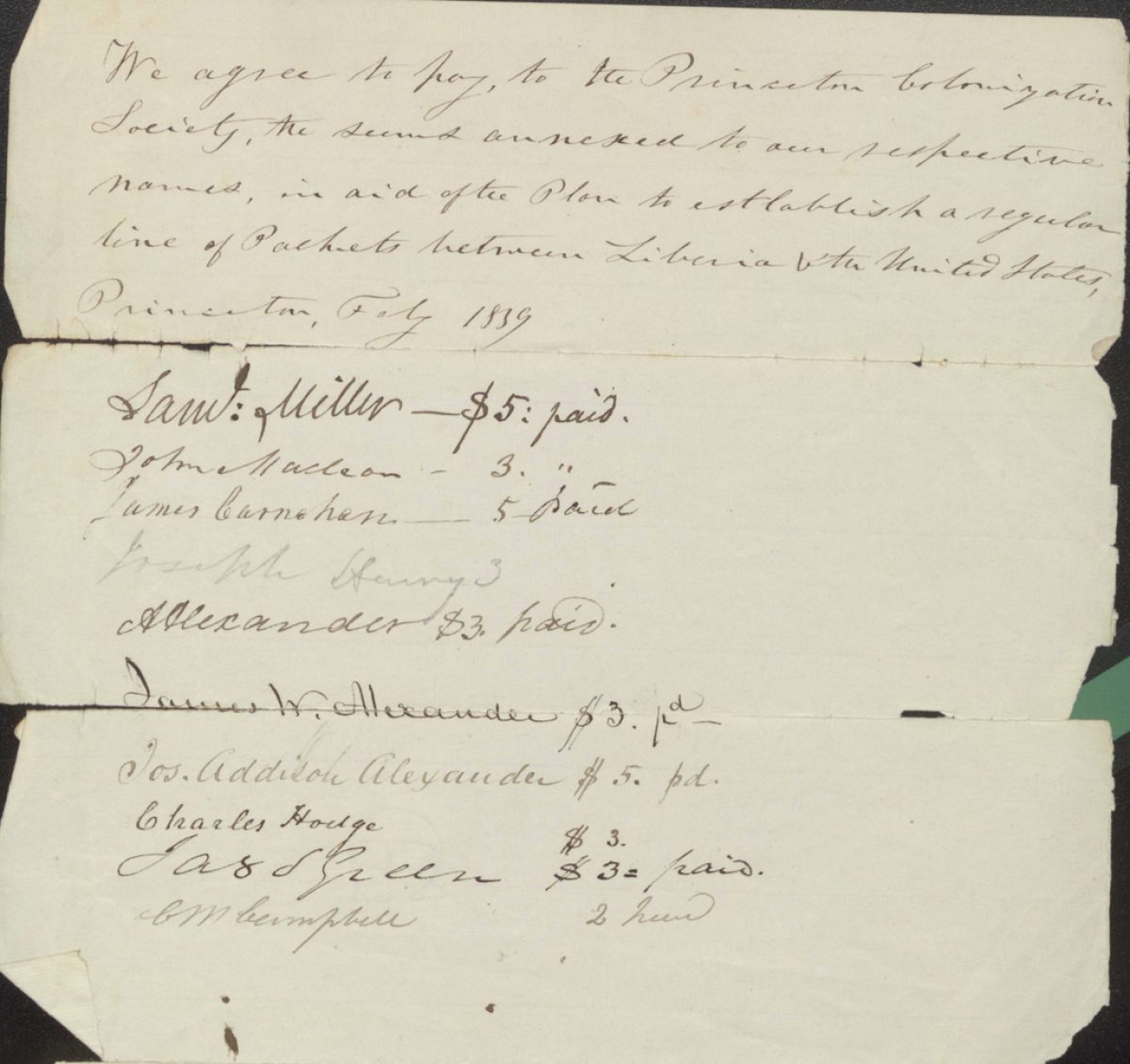
Donations pledged by Princeton faculty members to establish a packet line between Liberia and the United States.
View Primary Sources
Josiah F. C. Finley (‘1828) arrived in Monrovia in September 1834, where he served as superintendent of schools. The son of Robert Finley (‘1787), one of the founding architects of the American Colonization Society, he had strong family connections to the project. Three years later, he became governor of a quasi-independent settlement on the Sinoe River. Sponsored by the Mississippi State Colonization Society, the settlement’s capital town Greenville was named in honor of wealthy slaveholder and benefactor James Green (‘1809). In September 1838, while traveling from Greenville to Monrovia, Finley was assassinated by the Fishmen, a branch of the Kru people who asserted a monopoly on coastal trade. The circumstances of his death were murky, and his presence on board a ship belonging to the infamous slave trader Captain Canot raised concerns. The result was a dramatic increase in violence between colonists and indigenous groups. After discovering Finley’s corpse with “a very large gash on the back of the head,” a coalition of settlers and merchants, organized with help from Canot, launched a war that nearly destroyed the American colony at Bassa Cove.[6]

Newspaper report about Governor Josiah F. C. Finley (class of 1828), murdered near Liberia after departing a ship belonging to a slave trader.
View Primary Sources
The next two Princeton graduates to visit the region managed to avoid the intermittent warfare by settling outside of Liberian jurisdiction. Oren K. Canfield (‘1835) and Jonathan P. Alward (‘1836) had also attended the Princeton Theological Seminary, and unlike Finley, they were more concerned with religious conversion than colonial politics. The Board of Foreign Missions of the Presbyterian Church appointed Canfield and Alward to establish a new outpost in Africa, and they departed together in August 1839. Joined by former Liberian Governor and fellow seminarian John B. Pinney, they embarked on a whirlwind tour of potential sites between Cape Mesurado and Cape Palmas.[7]
Alward, who wrote a detailed account of their journey, was particularly impressed by the coastal town of Settra Kroo:
A number of large tribes, occupying a fine and apparently healthy country, may readily be reached from this point.[8]
Alward returned with his wife in 1841, but died of a fever before reaching the town. Canfield began construction of the mission but died of “bilious remittent fever” (probably malaria) about one year later. They were not alone in this experience. Liberian settlers suffered from “a crushing burden of infectious disease,” resulting in one of the highest mortality rates in recorded history.[9]
Princeton faculty members were fond of Canfield and Alward and kept up-to-date on their travels. Peter Harris Jr., described as “an African prince,” was another popular figure with missionaries and faculty. Arriving in the United States in the mid-1830s, Harris attended Lafayette College in Pennsylvania and visited the town of Princeton at the end of the decade. He became close with college professor and future president John Maclean Jr., a leader of the colonization movement, and seminary professor Archibald Alexander, who was hard at work on the first major history of Liberia. Harris joined Canfield and Alward on their exploratory mission in 1839 and wrote movingly about his reunion with family members near Bassa Cove. “I thank you sir for the kindness you have done for me,” he wrote to Maclean, “ten thousand thousand much oblige to you sir.”[10]
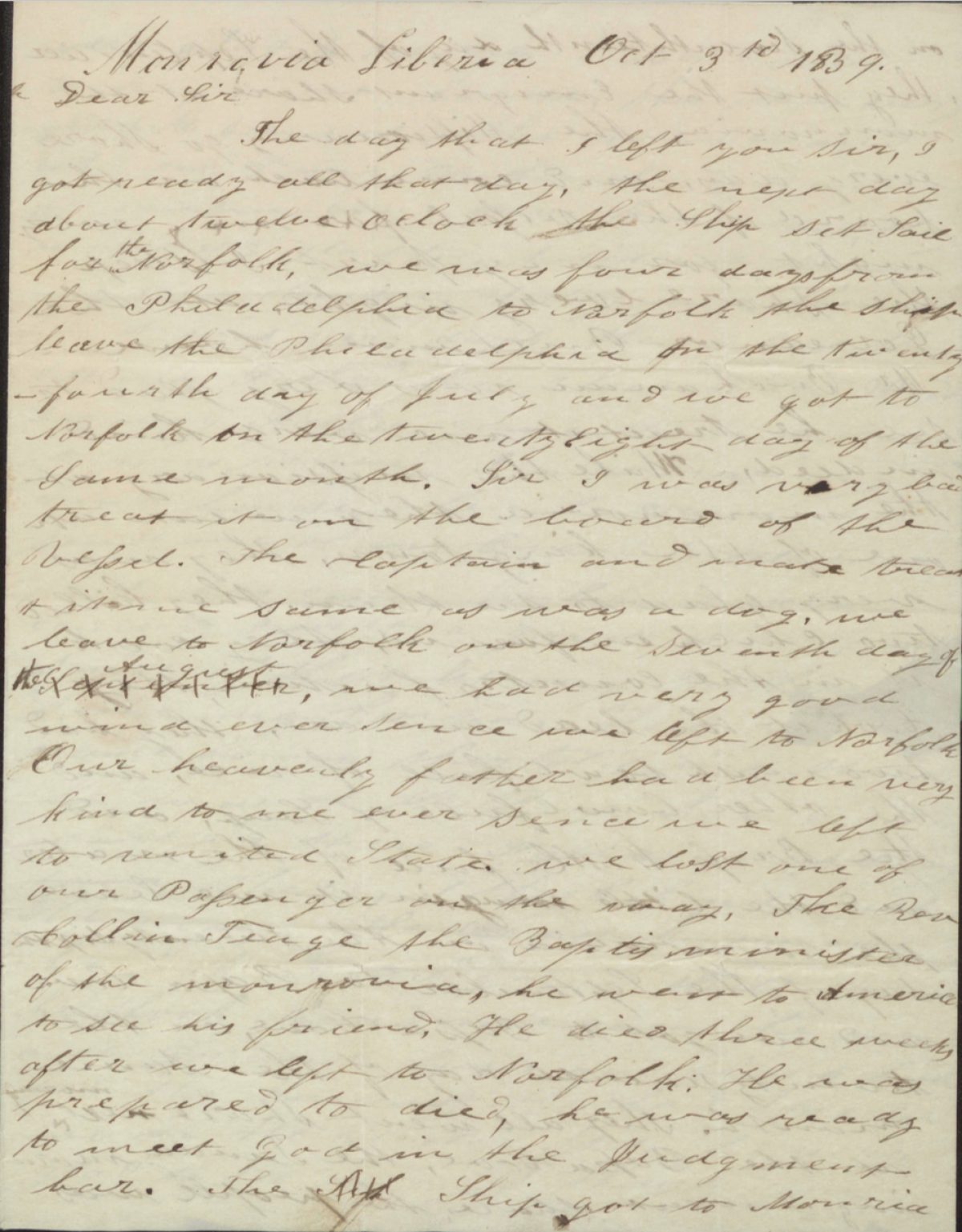
Letter from an African man, Peter Harris Jr., to Professor John Maclean Jr. about returning to his family near Bassa Cove, Liberia.
View Primary Sources
Harris established a small school under the auspices of his uncle, “King Joe.” He also wrote to members of Princeton’s Black community. The latter correspondence was, at least in part, orchestrated by the college faculty in order to persuade community leaders to abandon their support for abolition and embrace colonization.[11]
The Journal of Robert Wood Sawyer
Born in Goshen, New York, in 1813, Robert W. Sawyer worked as a farmer and school teacher before entering the College of New Jersey in the fall of 1834. According to his alumni biography:
He was above the average size and age of his classmates, staid and dignified in appearance, but affable and amiable and with a pleased and happy smile almost always on his face.[12]
A deeply pious Christian, Sawyer kept a journal of his spiritual progress as a student. Graduating in 1838, he immediately entered the Princeton Theological Seminary, where he continued his studies for another three years. During this time, he considered a career as a missionary to China or among Native Americans west of the Rocky Mountains. He spent his mornings teaching one of his servants to read and hoped to send him to Africa as a missionary. When his seminary classmate Jonathan Alward died attempting to establish a Presbyterian mission near Liberia, Sawyer volunteered to take his place. “Baptized for the dead,” as his superiors put it, he embarked on short notice for a land about which he knew almost nothing.[13]
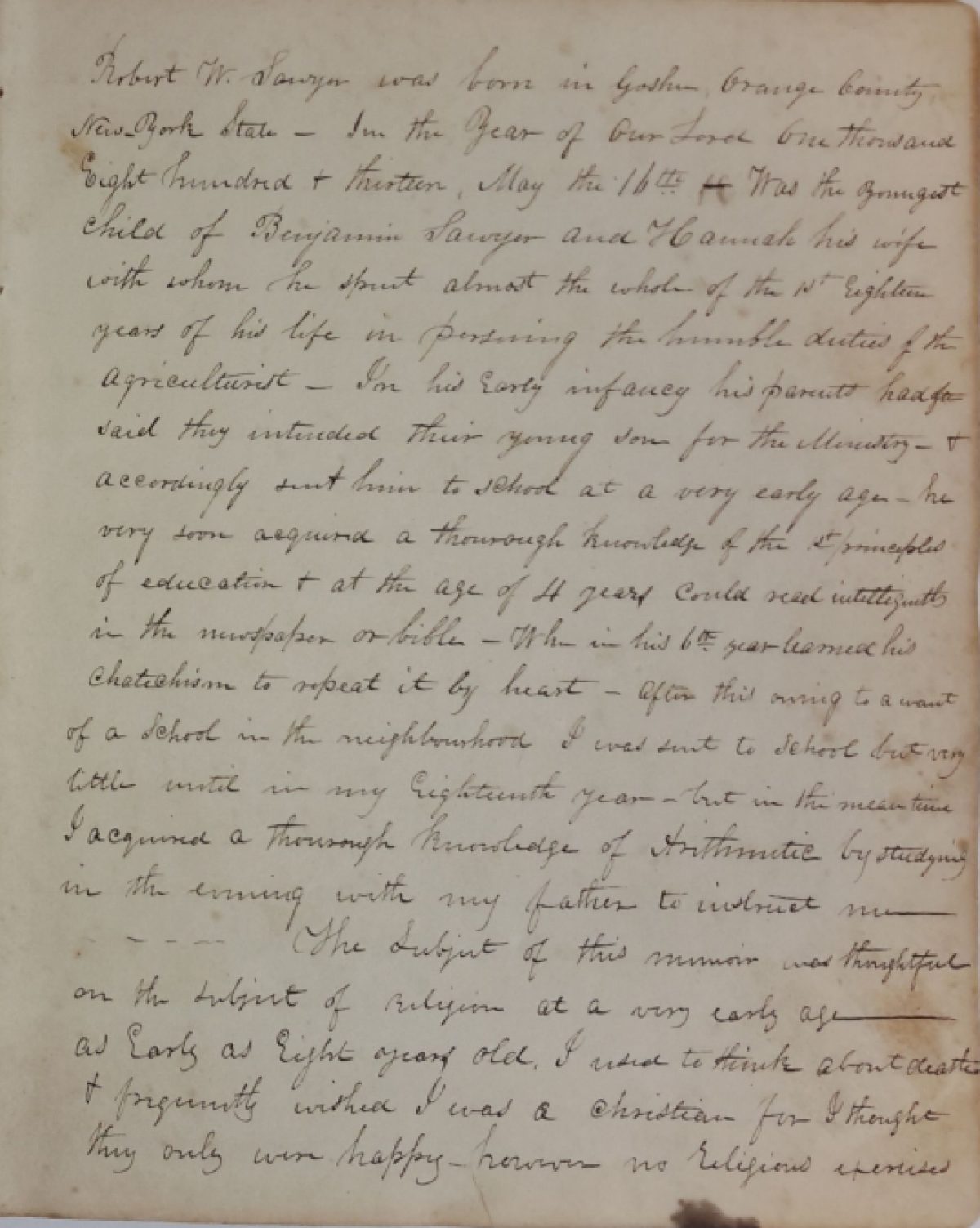
Robert Wood Sawyer's 1837-38 journal, in which he described his spiritual progress at Princeton.
View Primary Sources
Sawyer returned to Goshen, New York, in September 1841, where he was ordained a minister and married the following day to a local woman, Catherine Hammond. Husband and wife departed from New York City on October 6 and arrived in Monrovia in early December. By January, the couple had settled at Cape Palmas, where Sawyer met fellow college and seminary graduate Oren Canfield. The group stayed with American missionary John Leighton Wilson, who was married to the cousin of Princeton Seminary Professor Charles Hodge. Wilson, who maintained an intimate correspondence with Hodge, offered advice on working in Africa and instructed Sawyer in the local Grebo language. In April 1842, Canfield departed for Settra Kroo, the chosen location for their mission, but died about one month later. The Sawyers left Cape Palmas soon after receiving the grim news, and arrived at the mission site in June.[14]
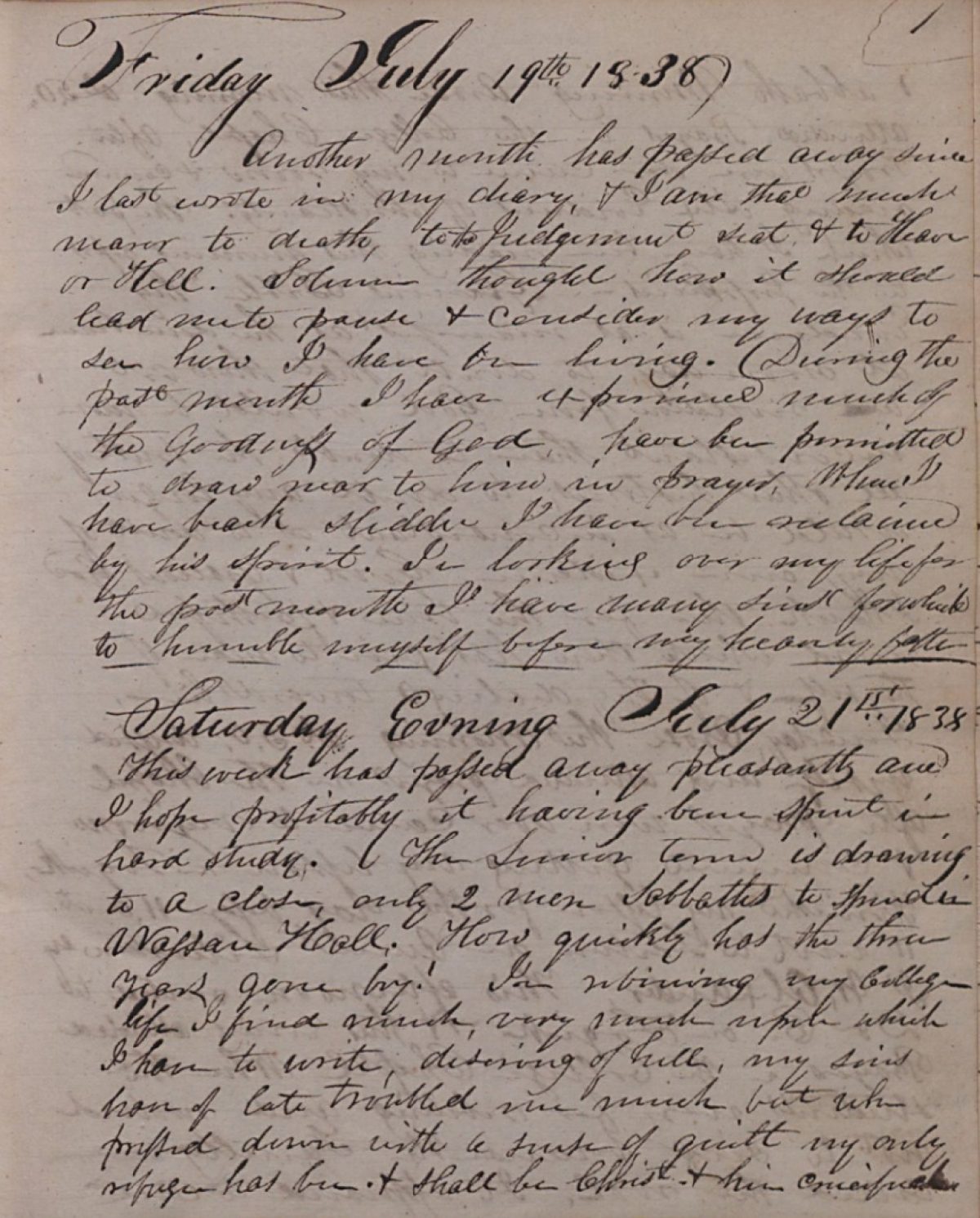
Robert Wood Sawyer's 1838-42 journal, in which he described his work as a missionary among the Kru people.
View Primary Sources
Settra Kroo hugged the coastline about halfway between Cape Palmas and Bassa Cove. One of the largest and most significant towns among the Kru people, it probably consisted of several thousand inhabitants, surrounded by rice and corn fields and herds of cattle. Like their relatives and competitors, the Fishmen, the Kru jealously guarded their monopoly on trade with the hinterland and resisted efforts by foreign powers to colonize their territory. Although adept at farming, they were also skilled mariners and traders who served on colonial and merchant vessels between Sierra Leone and the Ivory Coast, and they established migrant communities as far away as Nigeria and the Caribbean. Considered less belligerent than the Fishmen, the Kru were highly sought-after as navigators, sailors, and longshoremen. Both Kru and Fishmen served as middlemen between American and European slave traders and interior groups and, for the most part, were exempt from enslavement by their employers. Most adult males spoke at least some English as a result of their travels.[15]

Lithograph image of Settra Kroo, one of the five principal settlements of the Kru people, just north of Cape Palmas. Missionary house pictured on the far right.
View Primary Sources
The inhabitants of Settra Kroo were ambivalent about the white missionary couple in their midst. Although some welcomed them to the community, others viewed them as a dangerous and disruptive presence. One man, about thirty years old, expressed his reluctance to attain literacy. “Should he a grown man learn to read and write,” Sawyer explained, “the merchant at Sierra Leone would not give him employment and his countrymen would be afraid of his making witches for them.” A local leader complained that if he allowed a mission in his town “the Americans would come and take his country.” Another threatened to burn the mission and enslave its residents. Some stole supplies from the mission house or demanded money and presents. Sawyer probably made matters worse by claiming protection and retaliation from “the American People.” No doubt the Kru remembered the death of Governor Finley, only four years earlier, and the warfare that ensued.[16]
The missionaries established a small boarding school on their property, with an emphasis on religious education. Most students were male. “The heathen are much averse to have their female children educated,” claimed Catherine Sawyer. “They seem to think, the more ignorant the poor female is, the better slave she will be.” Sixteen-year-old Charles Hodge, a young African man renamed for the seminary professor, served as the primary interpreter for the mission. Robert Sawyer described him as “quite a good scholar, though at times he is rude and disposed to be refractory.” By July 1843, at least twenty boys from Settra Kroo had learned to read and about a dozen of their group had learned to write. Sawyer battled valiantly against what he called “their miserable superstitious and vile practices,” seeking to replace them with the allegedly superior superstitions and practices of American Presbyterianism. At the same time, he studied the Kru language, and Catherine prepared a bilingual spelling book. Their friends and family in the United States were never far from their minds, and the couple occasionally spent the day “in prayer for Princeton and her precious men and institutions.”[17]
Several Black American emigrants joined the mission community at Settra Kroo. Born near Princeton in 1813, Cecilia Van Tyne traveled to Africa with seminary students Alward and Canfield in 1841 and remained there for the next four years. Working with the Sawyers, she helped establish and manage the mission station and served as a teacher at the school. She later served as a missionary in Brazil. Like her contemporary, African American missionary and teacher Betsey Stockton, Van Tyne returned to Princeton. Known as “Aunt Celia,” she became a successful teacher and a prominent figure in Princeton’s Black community. Enslaved in Louisiana, Washington W. McDonogh earned his freedom with the condition that he emigrate to Liberia. He attended Lafayette College until 1842, when he embarked for Africa, and taught at the mission school with the Sawyers. Born into slavery in Kentucky, James M. Priest graduated from the New Albany Theological Seminary in Indiana and arrived at Settra Kroo in 1843. Entering politics, he served as a senator and as Vice President of Liberia during the 1860s.[18]
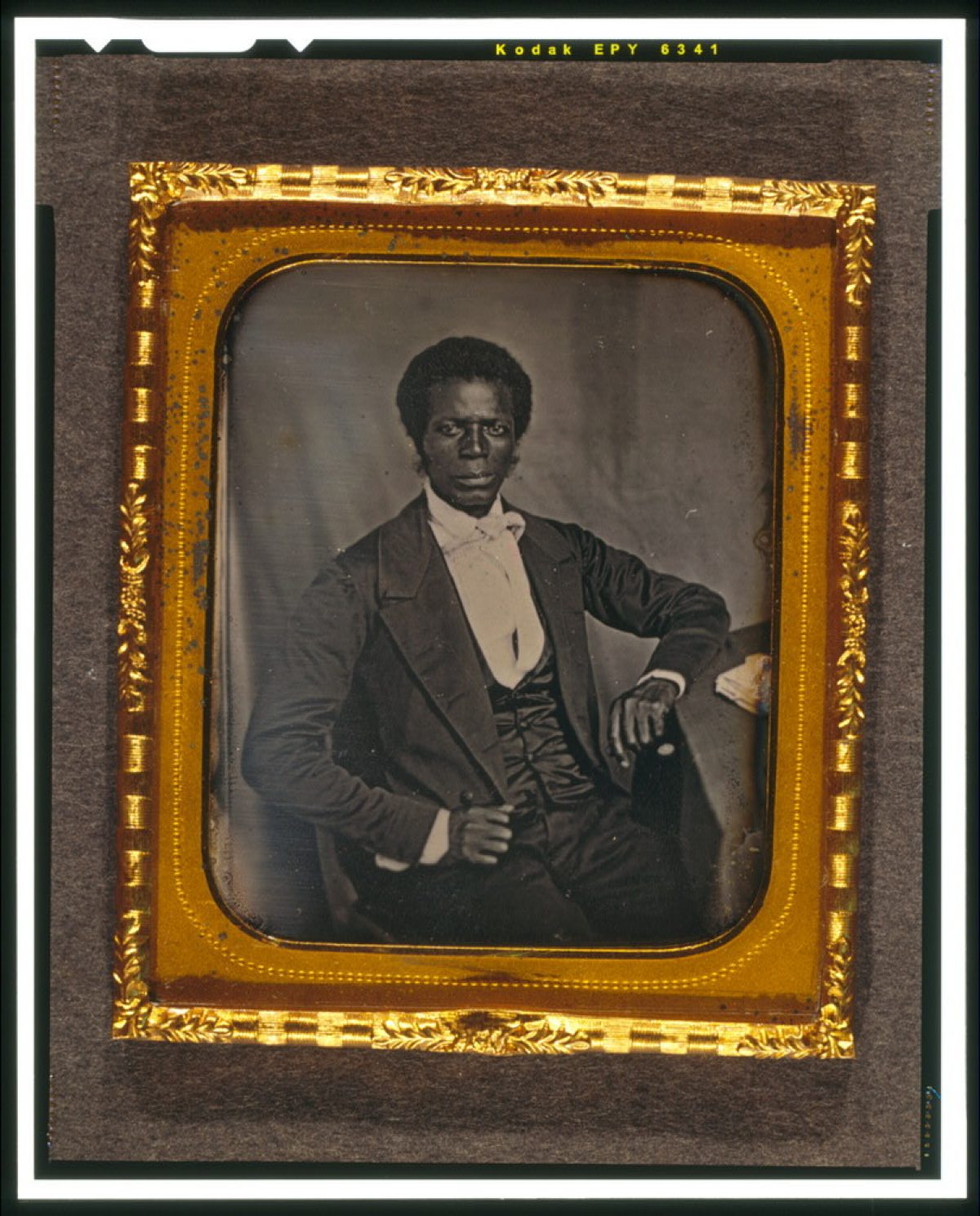
Portrait of James M. Priest, Vice President of Liberia from 1864-68. Priest was born a slave in Kentucky and emigrated to Liberia with the American Colonization Society.
View Primary Sources
A combination of environmental stressors, arduous labor, and infectious disease took a high toll on all of the missionaries. Washington McDonogh endured harrowing nosebleeds during the dry season. Catherine Sawyer lost her infant son soon after giving birth, and her husband suffered from chronic illness. In his journal, Robert Sawyer mentions the frequent use of something called “Blue Pill” (most likely calomel) in order to stave off disease. Probably weakened by mercury poisoning, he finally succumbed on the first day of December 1843. “He died after a short illness of 12 or 13 hours,” wrote McDonogh. “Still everything is going the same as when he was alive.” Catherine Sawyer remained at the mission, married the man sent to replace her husband, and eventually returned to the United States in 1850. McDonogh and Priest continued to operate schools in the region, assisted by two African teachers named in honor of their Princeton predecessors: Jonathan P. Alward and Robert W. Sawyer.[19]
Liberia formally declared independence in 1847, becoming the first democratic republic on the African continent. Its constitution explicitly banned slavery and the slave trade within its borders. It also restricted citizenship to “persons of color” and established a property qualification for suffrage, thereby disenfranchising most indigenous Africans. The event went virtually unnoticed in Princeton. By the middle of the 19th century, Finley, Alward, Canfield, and Sawyer, the four college graduates who had laid down their lives in Africa, were only a dim memory. Hugh Mason Browne and Thomas McCants Stewart, Black seminary students who attended classes at the College of New Jersey during the 1870s, traveled to Monrovia in 1883 to join the faculty of Liberia College. Both resigned after a few years. Stewart published an openly critical, but ultimately sympathetic account of the nation based on his experiences, and later returned to serve as an Associate Justice on the Liberian Supreme Court. Cecilia Van Tyne, the last living link to the Presbyterian mission at Settra Kroo, died in 1886 and was buried in Princeton.[20]
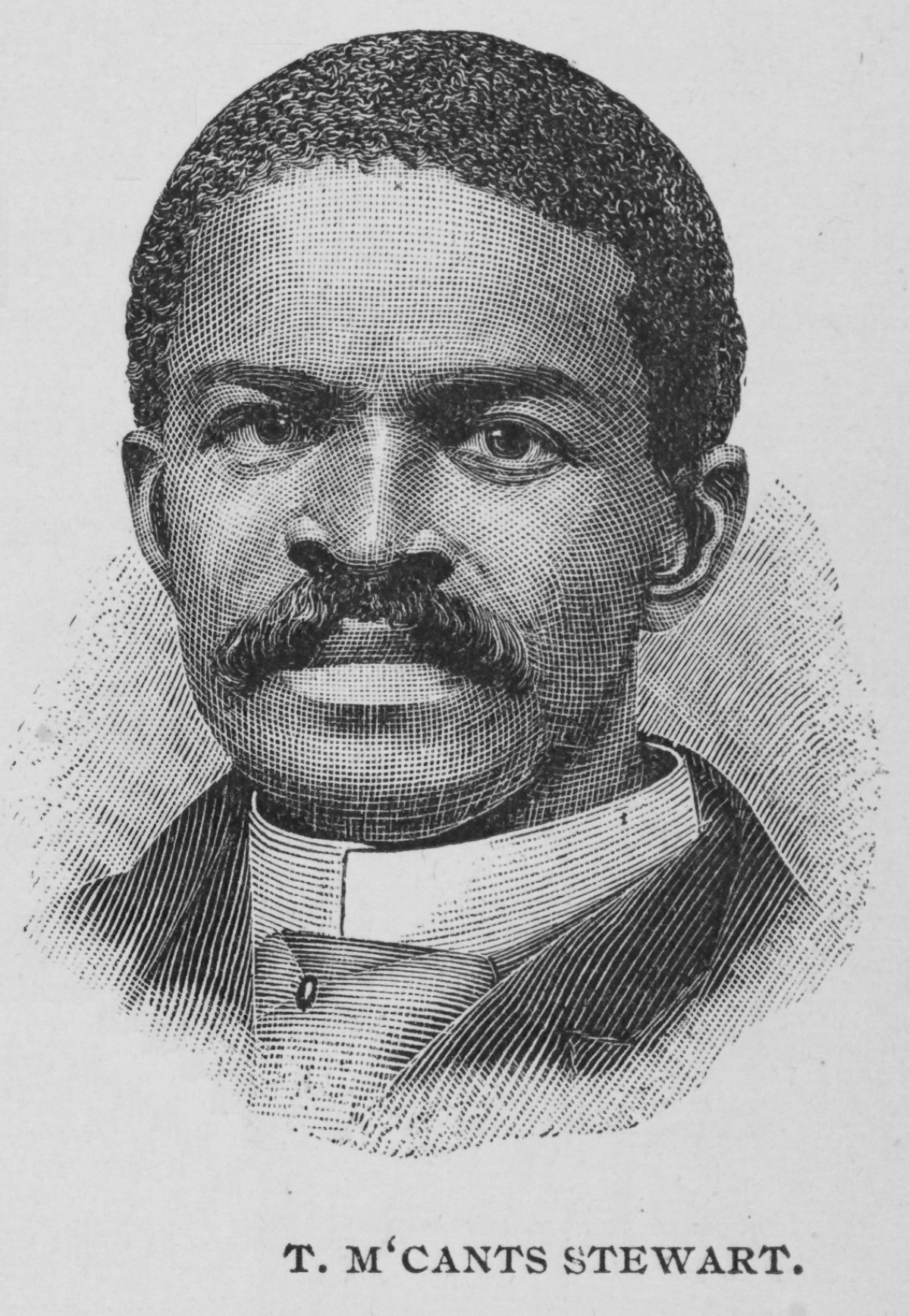
Portrait of Thomas McCants Stewart, Princeton Theological Seminary student who enrolled as a graduate student at Princeton under President James McCosh. Stewart later traveled to Monrovia, Liberia, to teach at Liberia College.
View Primary Sources
Firestone Library
In the first half of the 20th century, the histories of Liberia and Princeton intersected once again. In the aftermath of the First World War, the Firestone Tire and Rubber Company set its sights on West Africa in order to break the British and Dutch monopoly on one of the world’s most significant strategic resources: rubber. With the backing of the United States government, and under the personal direction of founder Harvey S. Firestone Sr., the company secured a controversial agreement with the government of Liberia. The terms, finalized in 1926, allowed Firestone a ninety-nine-year lease for one million acres of rubber plantations (about 1,500 square miles) employing 350,000 Liberians. Although development fell short of these projections, it was a gigantic project by any measure, and Firestone soon became the single largest employer in the country.[21]
Almost immediately, reports of coercive labor practices approximating slavery began to circulate. The allegations prompted an international investigation, which exonerated Firestone, but toppled the Liberian government and threatened the nation’s sovereignty. In the meantime, Firestone reaped enormous profits from the deal. The company remains a major force in the Liberian economy and continues to face criticism, most recently for its support of convicted war criminal Charles Taylor.[22]

African workers at a collection station of the Firestone Plantations Company near Cavalla, Liberia. Their buckets are loaded with latex.
View Primary Sources
All five of Harvey Firestone’s sons attended Princeton. During the 1920s, Harvey S. Firestone Jr. (‘1920) joined a team of experts scouting new sites for American rubber production for his father’s company. After an exhaustive worldwide tour, he helped to establish the Firestone Plantations Company, which oversaw the extraction industry in Liberia, and became its president in 1932. In a radio address in July of that year, the younger Firestone explained their choice of location as a natural outgrowth of the history of colonization:
Here, in this land, which had sprung from our own country, was the one spot on earth best suited to rubber-growing, where the spirit of America was a living force to form a bond of mutual understanding between the people and us.[23]
Firestone Jr. also highlighted the presence of a large population of native Africans, who would provide a reserve army of labor. Using language honed by generations of slave-owners and imperialists, he described the African workforce as cheerful, hardworking, and impervious to pain, a “trusting and childlike people.”[24]
Over the next several years, the Firestone Company flattened thousands of acres of rainforest and planted rows of genetically-modified rubber trees stretching for miles. White American supervisors, each responsible for 4,000 acres and 500 workers, assigned whimsical names to their indigenous employees, such as “Teacup,” “Beercase,” and “Julius Caesar,” which echoed the names given to enslaved laborers on antebellum plantations. The company constructed a hospital and sponsored teams of anthropologists, linguists, and scientists to study local cultures and the physical environment. At the same time, the Firestone family cultivated close relationships with Liberia’s top politicians, connections that proved lucrative for both parties.[25]
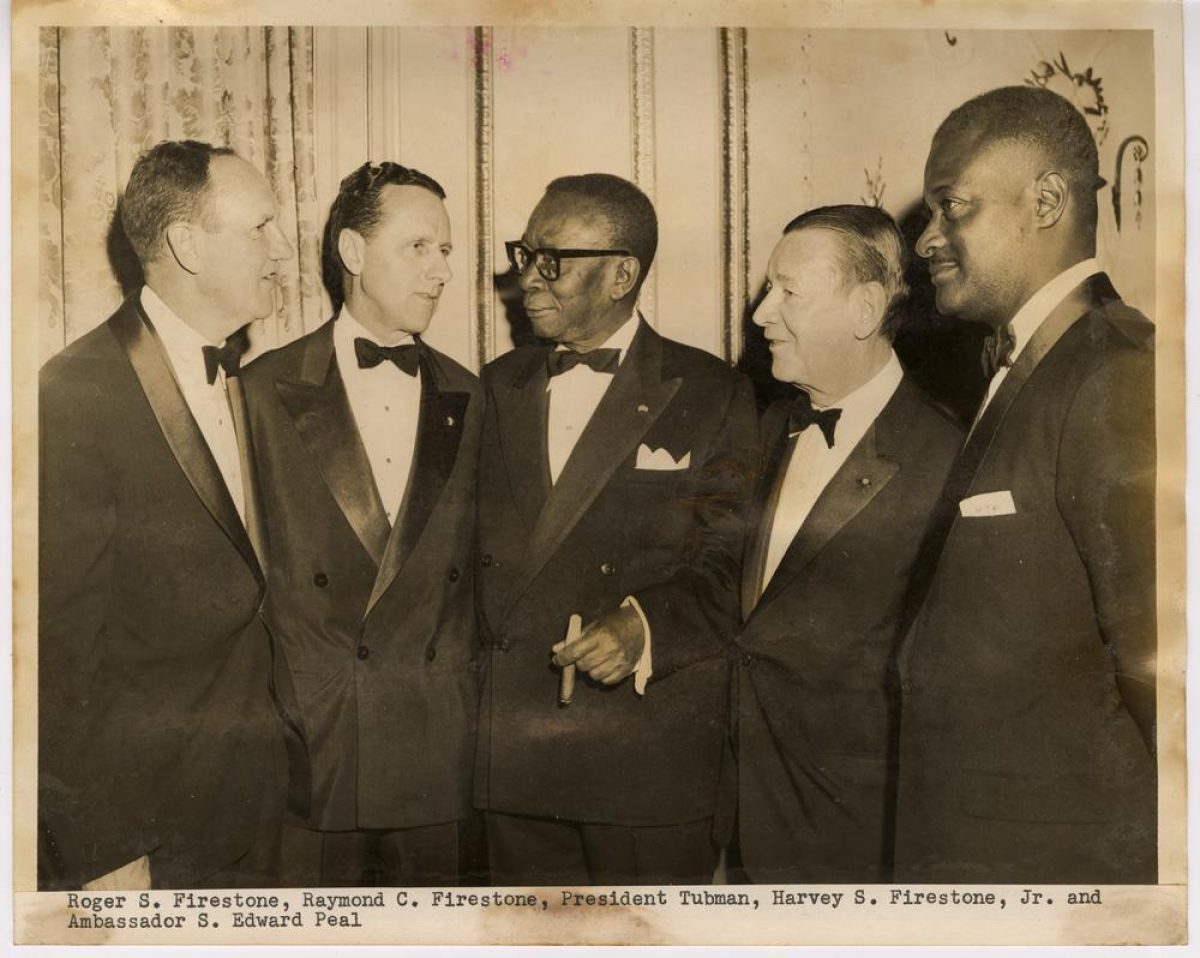
Photo of Liberian President William Tubman and Ambassador S. Edward Peal with Roger S. Firestone (‘1935), Raymond C. Firestone (‘1933), and Harvey S. Firestone Jr. (‘1920).
View Primary Sources
The profits from Liberia eventually made their way back to Princeton. In 1947, Harvey Firestone Jr., now President of the Firestone Company, used a silver trowel to lay the cornerstone of the school’s massive new library, named in honor of his father. The building’s vestibule features a large bust of the senior Firestone, cast in material that resembles the black rubber of an old car tire. The history of the small African nation and the workers that made his fortune possible are not mentioned anywhere on the library that bears his name.[26]
About the Author
Joseph Yannielli received his PhD from Yale and was the Perkins Postdoctoral Fellow in the Princeton Humanities Council. His work focuses on the history of slavery and abolition, with a special focus on America, West Africa, and the wider world during the nineteenth century. His other areas of interest include political and social movements, missionaries and religion, capitalism and globalization, and the United States in the world. At present, he is completing a book about the Mendi Mission and the role of Africa in the American abolition of slavery. He was the first project manager and lead developer of the Princeton & Slavery Project website, as well as several other digital history projects.
View all stories by Joseph Yannielli »
References
[1]
Eric Burin, “The Cape Mesurado Contract: A Reconsideration,” in New Directions in the Study of African-American Recolonization, eds. Beverly C. Tomek and Matthew J. Hetrick (Gainesville, FL: University Press of Florida, 2017), 229-248; Jonathan M. Bryant, Dark Places of the Earth: The Voyage of the Slave Ship Antelope (New York: Liveright, 2015), 264; Eric Robert Papenfuse, The Evils of Necessity: Robert Goodloe Harper and the Moral Dilemma of Slavery (Philadelphia: American Philosophical Society, 1997).
⤴
[2]
Bronwen Everill, Abolition and Empire in Sierra Leone and Liberia (Basingstoke: Palgrave Macmillan, 2013).
⤴
[3]
Proceedings of a Meeting Held at Princeton, New-Jersey, July 14, 1824, to Form a Society in the State of New-Jersey, to Cooperate with the American Colonization Society (Princeton, NJ: D. A. Borrenstein, 1824), 6.
⤴
[4]
Ben Wright, “‘The Heathen Are Demanding the Gospel’: Conversion, Redemption, and African Colonization,” in New Directions in the Study of African-American Recolonization, 50-69.
⤴
[5]
Catalogue of the American Whig Society, Instituted in the College of New Jersey, 1769 (Princeton, NJ: Published by Order of the Society, 1845), 47; Subscription to the Princeton Colonization Society, February 1839, folder 6, box 23, Office of the President Records (AC #117), Princeton University Archives, Department of Rare Books and Special Collections; John Maclean, History of the College of New Jersey: From Its Origin in 1746 to the Commencement of 1854, vol. 2 (Philadelphia: J. B. Lippincott & Co., 1877), 348-349. Colonizationists did fund the construction of a packet ship in Maryland in 1846. See Everill, Abolition and Empire, 133-134.
⤴
[6]
P. J. Staudenraus, The African Colonization Movement, 1816-1865 (New York: Columbia University Press, 1961), 140; Alan Huffman, Mississippi in Africa (New York: Gotham Books, 2004), 48. For accounts of Finley’s murder and the ensuing violence, see “Murder of Governor Finley” and “The Bassa War,” Africa’s Luminary, 15 March 1839; “Bassa War–Correction,” ibid., 3 May 1839; Rebecca B. Medbery, Memoir of William G. Crocker, Late Missionary in West Africa among the Bassas, including a History of the Bassa Mission (Boston: Gould, Kendall & Lincoln, 1848), 179-181; Théophile Conneau, A Slaver's Log Book, or 20 Years' Residence in Africa (Englewood Cliffs, NJ: Prentice-Hall, 1976), 258-262.
⤴
[7]
Jonathan P. Alward, “Journey to West Africa in search of a suitable spot for a mission,” Selected Papers of Jonathan Pennington Alward (C0379), folders 15-16, box 1, Princeton University Archives, Department of Rare Books and Special Collections.
⤴
[8]
“Report of Messrs. Pinney, Canfield and Alward,” Foreign Missionary Chronicle 8 (June 1840): 184.
⤴
[9]
“Memoir of the Rev. O. K. Canfield,” ibid. 10 (November 1842): 326; Antonio McDaniel, Swing Low, Sweet Chariot: The Mortality Cost of Colonizing Liberia in the Nineteenth Century (Chicago: University of Chicago Press, 1995), 104.
⤴
[10]
Joseph Henry to Harriet Henry, 19 July 1841, in The Papers of Joseph Henry, vol. 5, ed. Nathan Reingold (Washington, DC: Smithsonian Institution Press, 1985), 74-75; Frederick Freeman, Yaradee: A Plea for Africa, in Familiar Conversations on the Subject of Slavery and Colonization (Philadelphia: J. Whetham, 1836), 197; Archibald Alexander, A History of Colonization on the Western Coast of Africa (Philadelphia: William S. Martien, 1846); Peter Harris Jr. to John Maclean Jr., 3 October 1839, folder 6, box 23, Office of the President Records.
⤴
[11]
“Report of Messrs. Pinney, Canfield and Alward,” Foreign Missionary Chronicle 8 (July 1840): 215-216; James W. Alexander to John Hall, 26 February and 31 March 1840, in Forty Years' Familiar Letters of James W. Alexander, vol. 1, ed. John Hall (New York: Charles Scribner, 1860), 295, 297.
⤴
[12]
William Edward Schenck, Biography of the Class of 1838 of the College of New Jersey, at Princeton, N.J. (Philadelphia: Jas. B. Rodgers Printing Co., 1889), 127.
⤴
[13]
Journal of Robert Wood Sawyer, Class of 1838, Volume I and II, box 14, Student Correspondence and Writings Collection (AC334), Princeton University Archives, Department of Rare Books and Special Collections; “Extracts from Instructions of the Executive Committee of the Board of Foreign Missions to the Rev. Robert W. Sawyer and his Wife, Missionaries to Africa,” African Repository, and Colonial Journal 18 (November 15, 1841): 339.
⤴
[14]
Sawyer Journal, Volume II; “Memoir of the Rev. O. K. Canfield,” 324-327; Erskine Clarke, By the Rivers of Water: A Nineteenth-Century Atlantic Odyssey (New York: Basic Books, 2013), 25.
⤴
[15]
George E. Brooks, Jr., The Kru Mariner in the Nineteenth Century: An Historical Compendium (Newark, DE: Liberian Studies Association in America, 1972); Jane Martin, “Krumen ‘Down the Coast’: Liberian Migrants on the West African Coast in the 19th and Early 20th Centuries,” International Journal of African Historical Studies 18 (1985): 401-423.
⤴
[16]
Sawyer Journal, Volume II, 15 June 1842, 8 March 1843; The Sixth Annual Report of the Board of Foreign Missions of the Presbyterian Church, in the United States of America (New York: Published for the Board, 1843), 10.
⤴
[17]
The Seventh Annual Report of the Board of Foreign Missions of the Presbyterian Church, in the United States of America (New York: Published for the Board, 1844), 15; Sixth Annual Report of the Board of Foreign Missions, 11; “Memoir of the Rev. O. K. Canfield,” 328; Sawyer Journal, Volume II, 1 March 1843.
⤴
[18]
Lewis W. Mudge, “To the Editor of the Press,” Princeton Press, 27 March 1886; Bell I. Wiley, ed., Slaves No More: Letters from Liberia, 1833-1869 (Lexington, KY: University Press of Kentucky, 1980), 116-119; “Ordination of a Colored Missionary,” African Repository and Colonial Journal 19 (April 1843): 129; Le Roy J. Halsey, A History of the McCormick Theological Seminary of the Presbyterian Church (Chicago: Published by the Seminary, 1893), 9.
⤴
[19]
Sawyer Journal, Volume II; Washington W. McDonogh to John McDonogh, 7 February 1844, in Slaves No More, 128-129; Seventh Annual Report of the Board of Foreign Missions, 12-16; Schenck, Biography of the Class of 1838, 127-128; John C. Lowrie, A Manual of Missions: Or, Sketches of the Foreign Missions of the Presbyterian Church (New York: Anson D. F. Randolph, 1854), 32.
⤴
[20]
James Ciment, Another America: The Story of Liberia and the Former Slaves Who Ruled It (New York: Hill and Wang, 2013), 95; Thomas McCants Stewart, Liberia: The Americo-African Republic (New York: Edward O. Jenkins’ Sons, 1886); Mudge, “To the Editor of the Press.”
⤴
[21]
Ibrahim K. Sundiata, Black Scandal: America and the Liberian Labor Crisis, 1929-1936 (Philadelphia: Institute for the Study of Human Issues, 1980); Sundiata, Brothers and Strangers: Black Zionism, Black Slavery, 1914-1940 (Durham, NC: Duke University Press, 2003).
⤴
[23]
Harvey S. Firestone, Jr., The Romance and Drama of the Rubber Industry (Akron, OH: Firestone Tire and Rubber Company, 1936), 112.
⤴
[26]
“Library Cornerstone is Laid: Brief Ceremony Marks Progress on New Firestone Library Building,” Princeton Alumni Weekly 47 (4 July 1947): 13.
⤴















